Standard 60 mm Cage Plates
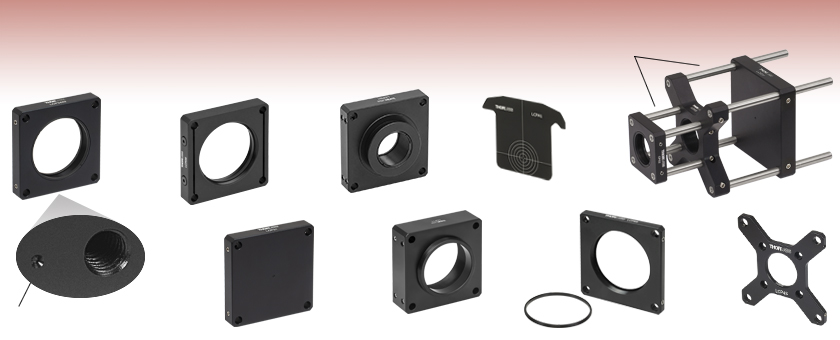
- Compatible with 60 mm Cage Systems
- Designed for Use with Ø6 mm ER Cage Rods
- Side-Located Setscrews to Secure Plates to Rods
LCP34/M
LCP08
LCP31
LCPA1
LCP11
Metric Indicator
CP33
ER Rods
LCP6S
LCP31
Application Idea
LCPN1
LCP33
LCP4S

Please Wait
| Alternative Size Options |
|---|
| 16 mm Cage Plates |
| 30 mm Cage Plates |
| 60 mm Cage Plates |
The Cage Assembly System provides a convenient way to construct large optomechanical systems using an established line of precision-machined building blocks designed for high flexibility and accurate alignment; see the Cage Overview tab for details. The 60 mm cage plates featured below provide a means for mounting Ø1", Ø1.5", Ø2", and Ø30 mm optical components within a cage system. Each cage plate includes four Ø6 mm bores for use with 60 mm cage rods. Additional quick-release cage plates for the 60 mm cage system are also available for applications that require elements to be inserted or removed from closed off cage structures.
Cage System Compatibility: Thorlabs offers 16 mm, 30 mm, and 60 mm cage systems designed for Ø1/2", Ø1", Ø30 mm, Ø1.5", or Ø2" optical components. The parts on this page are compatible with our 60 mm cage system and utilize Ø6 mm ER cage rods.
Selection Guide
| Item # | Product Description | Inner Bore | Post Mounting Hole |
|---|---|---|---|
| LCP10(/M) | 0.5" Thick Cage Plate for Ø1.5" Optics | SM1.5 Threaded | 8-32 (M4) |
| LCP34(/M) | 0.5" Thick Cage Plate | SM2 Threaded | 8-32 (M4) |
| LCP34T(/M) | 0.9" Thick Cage Plate | SM2 Threaded | 8-32 (M4) |
| LCP08 (/M) | 0.5" Thick Cage Plate with Enhanced Clamping | SM2 Threaded | 8-32 (M4) |
| LCP11(/M) | 1.15" Thick Cage Plate with External and Internal Threads | SM2 Threaded | 8-32 (M4) |
| LCP6S | 6 mm Thick Cage Plate | SM2 Threaded | None |
| LCP8S | 8 mm Thick Cage Plate | SM2 Threaded | None |
| LCP35(/M) | Cage Plate with Ø2" Bore for Optics | Ø2" Double Bore with Setscrew | 8-32 (M4) |
| LCP36 | Cage Plate with Ø2.2" Bore for Lens Tubes | Ø2.2" Double Bore with Setscrew | None |
| LCPN6 | Cage Plate with Dovetail and SM1 Threads for Lens Tubes | SM1 Threaded | None |
| LCPN1, LCPN2, LCPN3, and LCPY2 | Cage Plates with Dovetails and SM30 Threads for Ø30 mm Optics | SM30 Threaded | None |
| CSN110 | Cage Plate with Dovetail and M32 x 0.75 Threads | M32 x 0.75 Threaded | None |
| LCPN4 and LCPN5 | Cage Plates with Dovetails and SM2 Threads for Ø2" Optics | SM2 Threaded | None |
| LCPY3 | Cage Plate with Dovetail for Olympus Trinoculars | None | None |
| LCP4S | 30 mm to 60 mm Cage Plate Adapter, 0.16" Thick | SM1 Threaded | None |
| LCP6X | 30 mm to 60 mm Cage Plate Adapter, 0.24" Thick | SM1 Threaded | None |
| LCP33(/M) | 30 mm to 60 mm Cage Plate Adapter, 0.5" Thick | SM1 Threaded | 8-32 (M4) |
| LCP31(/M) | Blank Cage Plate | None | 8-32 (M4) |
| LCPA1 | Alignment Guide for the 60 mm Cage System | ||
Cage System Overview
The Cage Assembly System provides a convenient way to construct large optomechanical systems with an established line of precision-machined building blocks designed for high flexibility and accurate alignment.
16 mm, 30 mm, and 60 mm Cage System Standards
Thorlabs offers three standards defined by the center-to-center spacing of the cage assembly rods (see Figure 14A). The 16 mm cage, 30 mm cage, and 60 mm cage standards are designed to accommodate Ø1/2", Ø1", and Ø2" optics, respectively. Specialized cage plates that allow smaller optics to be directly inserted into our larger cage systems are also available.
Standard Threads
The flexibility of our Cage Assembly System stems from well-defined mounting and thread standards designed to directly interface with a wide range of specialized products. The three most prevalent thread standards are our SM05 Series (0.535"-40 thread), SM1 Series (1.035"-40 thread), and SM2 Series (2.035"-40 thread), all of which were defined to house the industry's most common optic sizes. Essential building blocks, such as our popular lens tubes, directly interface to these standards.

Figure 14A An example of the standard cage plate measurements determining cage system compatibility.
| Standard Cage System Measurements | |||
|---|---|---|---|
| Cage System | 16 mm | 30 mm | 60 mm |
| Thread Series | SM05 | SM1 | SM2 |
| Rod to Rod Spacing | 16 mm (0.63") | 30 mm (1.18") | 60 mm (2.36") |
| Total Length | 25 mm (0.98") | 41 mm (1.60") | 71.1 mm (2.80") |
| Cage Components | ||
|---|---|---|
| Cage Rods | 16 mm | These rods are used to connect cage plates, optic mounts, and other components in the cage system. The SR Series Cage Rods are compatible with our 16 mm cage systems, while the 30 mm and 60 mm cage systems use ER Series Cage Rods. |
| 30 mm | ||
| 60 mm | ||
| Cage Plates | 16 mm | These serve as the basic building blocks for a cage system. They may have SM-threaded central bores, smooth bores sized for industry standard optics or to accommodate the outer profile of our SM Series Lens Tubes, or specialized bores for other components such as our FiberPorts. |
| 30 mm | ||
| 60 mm | ||
| Optic Mounts | 16 mm | Thorlabs offers fixed, kinematic, rotation, and translation mounts specifically designed for our Cage Systems. |
| 30 mm | ||
| 60 mm | ||
| Cage Cubes | 16 mm | These cubes are useful for housing larger optical components, such as prisms or mirrors, or optics that need to sit at an angle to the beam path, such as beamsplitters. Our cage cubes are available empty or with pre-mounted optics. |
| 30 mm | ||
| 60 mm | ||
| Replacement Setscrews | Replacement setscrews are offered for our 16 mm (SS4B013, SS4B025, and SS4B038) and 30 mm (SS4MS5 and SS4MS4) cage systems products. | |
| Post and Breadboard Mounts and Adapters | Mounting options for cage systems can be found on our Cage System Construction pages. Cage Systems can be mounted either parallel or perpendicular to the table surface. | |
| Size Adapters | Cage System Size Adapters can be used to integrate components from different cage system and threading standards. | |
| Specialized Components | Thorlabs also produces specialized cage components, such as Filter Wheels, a HeNe Laser Mount, and a FiberPort Cage Plate Adapter, allowing a wide range of our products to be integrated into cage-mounted optical systems. Explore our Cage Systems Visual Navigation Guide to see the full range of Thorlabs' cage components. | |
| Table 76C Thorlabs Dovetail Referencea | |||
|---|---|---|---|
| Type | Shape | Outer Dimension | Angle |
| 95 mm | Linear | 95 mm | 45° |
| D1N | Circular | Ø2.018" | 60° |
| D2Nb | Circular | Ø1.50" | 90° |
| D2NBb | Circular | Ø1.50" | 90° |
| D3N | Circular | Ø45 mm | 70° |
| D5N | Circular | Ø1.58" | 90° |
| D6N | Circular | Ø1.90" | 90° |
| D7N | Circular | Ø2.05" | 90° |
| D8N | Circular | Ø40 mm | 90° |
| D9N | Circular | Ø50 mm | 90° |
| D10N | Circular | Ø52 mm | 90° |
| D1T | Circular | Ø1.50" | 60° |
| D3T | Circular | Ø1.65" | 90° |
| D4T | Circular | Ø1.20" | 90° |
| D1Y | Circular | Ø107 mm | 60° |
| D2Y | Circular | Ø2.32" | 50° |
| D3Y | Circular | Ø1.75" | 90° |
| D4Y | Circular | Ø56 mm | 60° |
| D5Y | Circular | Ø46 mm | 60° |
| D6Y | Circular | Ø41.9 mm | 45° |
| D1Z | Circular | Ø54 mm | 60° |
| D2Z | Circular | Ø57 mm | 60° |
| D3Z | Circular | Ø54 mm | 45° |

Click to Enlarge
Figure 76B This photo shows the male D1N dovetail on the trinoculars next to the female D1N dovetail on the epi-illumination arm.
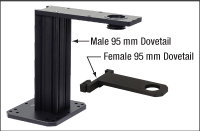
Click to Enlarge
Figure 76A This photo shows the male 95 mm dovetail on the microscope body and the female 95 mm dovetail on the CSA1002 Fixed Arm.
Introduction to Microscope Dovetails
Dovetails are used for mechanical mating and optical port alignment of microscope components. Components are connected by inserting one dovetail into another, then tightening one or more locking setscrews on the female dovetail. Dovetails come in two shapes: linear and circular. Linear dovetails allow the mating components to slide before being locked down, providing flexible positioning options while limiting unneeded degrees of freedom. Circular dovetails align optical ports on different components, maintaining a single optical axis with minimal user intervention.
Thorlabs manufactures many components which use dovetails to mate with our own components or those of other manufacturers. To make it easier to identify dovetail compatibility, we have developed a set of dovetail designations. The naming convention of these designations is used only by Thorlabs and not other microscope manufacturers. Table 76C lists all the dovetails Thorlabs makes, along with their key dimensions.
In the case of Thorlabs’ Cerna® microscopes, different dovetail types are used on different sections of the microscope to ensure that only compatible components can be mated. For example, our WFA2002 Epi-Illuminator Module has a male D1N dovetail that mates with the female D1N dovetail on the microscope body's epi-illumination arm, while the CSS2001 XY Microscopy Stage has a female D1Y dovetail that mates with the male D1Y dovetail on the CSA1051 Mounting Arm.
To learn which dovetail type(s) are on a particular component, consult its mechanical drawing, available by clicking on the red Docs icon (![]() ) below. For adapters with a female dovetail, the drawing also indicates the size of the hex key needed for the locking setscrew(s). It is important to note that mechanical compatibility does not ensure optical compatibility. Information on optical compatibility is available from Thorlabs' web presentations.
) below. For adapters with a female dovetail, the drawing also indicates the size of the hex key needed for the locking setscrew(s). It is important to note that mechanical compatibility does not ensure optical compatibility. Information on optical compatibility is available from Thorlabs' web presentations.
For customers interested in machining their own dovetails, Table 76C gives the outer diameter and angle (as defined by Figures 76D and 76E) of each Thorlabs dovetail designation. However, the dovetail's height must be determined by the user, and for circular dovetails, the user must also determine the inner diameter and bore diameter. These quantities can vary for dovetails of the same type. One can use the intended mating part to verify compatibility.
In order to reduce wear and simplify connections, dovetails are often machined with chamfers, recesses, and other mechanical features. Some examples of these variations are shown by Figures 76D and 76E.

Click to Enlarge
Figure 76D Two examples of how circular male dovetails can be manufactured.

Click to Enlarge
Figure 76E Two examples of how circular female dovetails can be manufactured.
| Posted Comments: | |
user
(posted 2022-07-26 13:34:18.33) The 3D model (both STEP and SolidWorks) are incorrect for LCP08. It appears that the SM2 bore is not properly centered, and/or two of the guide rod bores are located incorrectly. Additionally, the plate is not square as it should be. Could you please correct this model? The errors make it difficult to assemble our complete design in CAD space. jdelia
(posted 2022-08-09 04:11:24.0) Thank you for contacting Thorlabs and for bringing this to our attention. We have corrected and updated the models for LCP08(/M) on our website. David Hill
(posted 2022-02-18 02:45:48.523) Hello Thorlabs,
I am curious about the possibility of having cage system parts produced in custom materials, specifically copper?
Use of copper would make it possible to mount optics inside large cryostats and guarantee thermalization of the mounted optics. jgreschler
(posted 2022-02-18 11:23:34.0) Thank you for reaching out to Thorlabs. While we do offer customization of bulk materials in some cases, copper is unfortunately not an available option. For future custom requests, please contact techsales@thorlabs.com Jairus Martin
(posted 2020-03-04 12:25:30.67) In the overview section of https://www.thorlabs.com/newgrouppage9.cfm?objectgroup_id=3021
The link to quick-release cage plates is not found when I click it. tcampbell
(posted 2020-03-04 02:18:43.0) Hello and thank you for pointing out this error. We have corrected this link so that it directs to the appropriate page. t.dzelzainis
(posted 2016-03-09 17:42:25.547) Hi,
Just an idea. I think it would be useful to do cage mount plates which had two holes for post mounting spaced at 25mm to match a breadboard. Often cage mounts have long extensions which make them very susceptible to accidental rotations. Being able to mount on two posts would eliminate this problem. Also it would allow people to build their own version of your U-bench.
Cheers,
Tom. besembeson
(posted 2016-03-10 03:59:22.0) Response from Bweh at Thorlabs USA: Thanks very much for your suggestion. We will review this. lcoutu
(posted 2015-06-05 03:12:35.893) Is it possible to have this product in the metric system? besembeson
(posted 2015-08-28 05:16:36.0) Response from Bweh at Thorlabs USA: The cage systems are universal and they work for both metric and imperial systems. The interconnecting components have no metric or imperial versions generally. tcohen
(posted 2012-06-14 10:39:00.0) Response from Tim at Thorlabs: Thank you for your feedback! We like this idea and will add this functionality to the product. We are currently working on releasing many new products and as soon as the workload lightens we will implement your design. Thank you again for sharing your time and idea! schneider
(posted 2012-06-08 12:51:22.0) A remark: It would be nice to have the LCP02 also post mountable. Javier
(posted 2010-06-10 15:18:41.0) Response from Javier at Thorlabs to jc7: we may be able to offer this as a special item. I will contact you with more information. jc7
(posted 2010-06-09 17:09:13.0) Hello, Is it possible to make the 30 mm to 60 mm Cage Plate Adapter (LCP02) with a Nylon-Tipped Thumbscrew as an Fixed Ø1" Optic Mount instead of the SM1 threading? I would like to mount a Beam Expander (BE05M) in my mostly 30mm cage system. |

- Directly Accepts Ø1.5" Optics up to 0.3" (7.6 mm) Thick
- Mount Optics Within a 60 mm Cage System Assembly
- Tapped with our Standard Internal SM1.5 (1.535"-40) Thread
- 8-32 (M4) Tapped Hole for Mounting to Ø1/2" Posts
The LCP10(/M) SM1.5-Threaded Cage Plate provides a center-located SM1.5 (1.535"-40) threaded bore that accepts a Ø1.5" optic up to 0.3" (7.6 mm) thick. Two SM1.5RR retaining rings, providing a Ø1.38" (Ø34.9 mm) clear aperture, are included to hold an optic within the cage plate. Each cage rod through hole has a side-located locking setscrew that can be tightened to hold a cage rod in place using a 5/64" (2.0 mm) hex key. For additional convenience, an 8-32 (M4) tapped hole is provided for post mounting. As with the LCP34/M cage plate shown at the top of the page, the LCP10/M cage plate has a small dimple next to the threaded hole to indicate that it is a metric part.

- Directly Accepts Ø2" Optics up to 0.35" (8.9 mm) Thick
- Mount Optics Within a 60 mm Cage System Assembly
- Tapped with our Standard SM2 (2.035"-40) Thread
- 8-32 (M4) Tapped Hole for Mounting to Ø1/2" Posts
The LCP34(/M) SM2-Threaded Cage Plate is among our most popular 60 mm cage plates. It provides a center-located SM2 (2.035"-40) threaded bore that accepts a Ø2" optic up to 0.35" (8.9 mm) thick. Two SM2RR retaining rings, providing a Ø1.90" (Ø48.3 mm) clear aperture, are included to hold an optic within the cage plate. The cage rod through holes have side-located locking setscrews for securing the position of the LCP34(/M) within the cage; use a 5/64" (2.0 mm) hex key to lock the cage plate in place. For additional convenience, an 8-32 (M4) tapped hole is provided for post mounting and OEM-mounting applications. As shown in the image at the top of the page, the LCP34/M has a small dimple to indicate that it is a metric part.

- Directly Accepts Ø2" Optics up to 0.70" (17.8 mm) Thick
- Mount Optics Within a 60 mm Cage System Assembly
- Tapped with Our Standard SM2 (2.035"-40) Thread
- 8-32 (M4) Tapped Hole for Mounting to Ø1/2" Posts
The LCP34T(/M) 0.9" Thick Cage Plate is designed for cage mounting of Thorlabs' thickest Ø2" optics. The center-located SM2-threaded (2.035"-40) bore is designed to hold optics up to 0.70" (17.8 mm) thick. Two SM2RR retaining rings, providing a Ø1.90" (Ø48.3 mm) clear aperture, are included to hold an optic within the cage plate. The cage rod through holes have side-located, 5/64" (2.0 mm) hex locking setscrews for securing the position of the LCP34T(/M) plate within the cage. Additionally, an 8-32 (M4) tapped hole is provided for post-mounting applications. Like the LCP34/M, the LCP34T/M has a small dimple to indicate that it is a metric part (see the image at the top of the page).

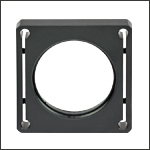
Click to Enlarge
Figure 407A View of the Flexure Clamping Mechanism
- Directly Accepts Ø2" Optics up to 0.35" (8.9 mm) Thick
- Mounts Optics Within a 60 mm Cage System Assembly
- Tapped with Our Standard SM2 (2.035"-40) Thread
- 8-32 (M4) Tapped Hole for Mounting to Ø1/2" Posts
The LCP08(/M) Cage Plate with Enhanced Clamping improves upon the popular LCP34(/M) design, providing the same center-located SM2-threaded (2.035"-40) bore and 8-32 (M4) mounting hole, but offering a more stable flexure clamping mechanism for our standard ER rods. Four cap screws, each with a 5/64" (2.0 mm) hex, activate the flexure clamp, which increases the surface area in contact with the ER rods. The center-threaded bore of the LCP08(/M) can directly accept a Ø2" optic up to 0.35" (8.9 mm) thick. One SM2RR retaining ring is included, providing a Ø1.90" (Ø48.3 mm) clear aperture; for direct mounting of optics, a second SM2RR must be purchased. Thicker optics may be mounted in an SM2 Lens Tube, which can be threaded onto the cage plate. As with the LCP34/M shown at the top of the page, the LCP08/M also features a small dimple indicating it is a metric part.

- Directly Accepts Ø2" Optics up to 0.65" (16.5 mm) Thick
- Mount Optics Within a 60 mm Cage System Assembly
- Internal and External SM2 (2.035"-40) Threading
- 8-32 (M4) Tapped Hole for Mounting to Ø1/2" Posts
- Add or Remove SM2-Threaded Components Independent of the Mounted Optic
The LCP11(/M) Cage Plate provides cage mounting of Ø2" optics along with SM2-threaded components. It features an internally SM2-threaded (2.035"-40) bore on one side with an externally SM2-threaded bore on the other side, providing a clear aperture of Ø1.75" (Ø44.5 mm). One SM2RR retaining ring is provided and can be used to secure an optic against the internal lip of the cage plate; thicker retaining rings are available for high-curvature lenses. The cage rod through holes have side-located locking 8-32 setscrews, each with a 5/64" (2 mm) hex, for securing the position of the LCP11(/M) within the cage system. Additionally, an 8-32 (M4) tapped hole is provided for post-mounting applications. As with the LCP34/M shown at the top of the page, the LCP11/M also features a small dimple indicating it is a metric part.

- Directly Accept Ø2" Optics up to 0.12" (3 mm) Thick
- Two Thicknesses Available: 6 mm and 8 mm
- Tapped with Our Standard SM2 (2.035"-40) Thread
- Not Post Mountable
The LCP6S and LCP8S Cage Plates provide cage mounting of Ø2" optics along with SM2-threaded components. At 6 mm and 8 mm thick, they have a thinner profile than most other 60 mm cage plates we offer. Each plate has a center-located, SM2-threaded bore that is compatible with our SM2-threaded optomechanical components. One SM2RR retaining ring is provided for the LCP6S and can be used to secure an optic against the internal lip of the cage plate. The SM2RR retaining ring has a clear aperture of Ø1.90" (Ø48.3 mm) and a thickness of 0.10" (2.5 mm). The LCP8S has threads that go all the way through the part for an 8 mm thread depth. Retaining rings are not included with the LCP8S, but may be purchased separately. The thinness of these plates allows the close spacing of optical components within a cage system. The cage rod through holes have side-located locking M4 setscrews, which can be secured using a 5/64" (2.0 mm) hex key. Unlike the LCP34(/M) and the LCP34T(/M) sold above, these cage plates do not offer a tapped hole for post mounting.

- Directly Accepts a Ø2" (Ø50.8 mm) Optic at Least 0.27" (6.9 mm) Thick
- Mounts Optics Within a 60 mm Cage System Assembly
- Nylon-Tipped Setscrew Secures Optic
- 8-32 (M4) Tapped Hole for Mounting to Ø1/2" Posts
The LCP35(/M) Cage Plate features a Ø2.00" double bore which centers the optic. A nylon-tipped locking setscrew provides a third point of contact and secures optics at least 0.27" (6.9 mm) thick. Each cage rod through hole includes a side-located, 5/64" (2.0 mm) hex locking setscrew for securing the position of the LCP35(/M) within a 60 mm cage system. For additional convenience, an 8-32 (M4) tapped hole is provided for post mounting and OEM mounting applications. As with the LCP34/M shown at the top of the page, the LCP35/M also features a small dimple indicating it is a metric part.

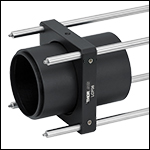
Click to Enlarge
Figure 411A The LCP36 cage plate secures SM2 lens tubes in a 60 mm cage system.
- Ø2.2" (Ø56.0 mm) Bore Supports Outside Diameter of SM2 Lens Tubes
- Compatible with 60 mm Cage Systems
- Nylon-Tipped Setscrew and Double Bore Securely Hold Lens Tubes
- Not Post Mountable
The LCP36 Cage Plate is designed to allow our SM2 lens tubes to slide into the cage plate and be locked in position with a nylon-tipped setscrew. This cage plate is ideal for situations where it is not desirable to thread the lens tube into one of our threaded cage plates. A double-bore design gives three points of contact for stable and secure mounting. Each cage rod through hole is accompanied by a side-located locking M4 x 0.7 setscrew, which can be secured using a 5/64" (2.0 mm) hex key.
Please note that this plate does not feature a tapped mounting hole, unlike many of our other cage plates. Due to the bore size, there would be interference between the threaded stud on our Ø1/2" posts and the clear aperture of the bore. Therefore, this cage plate cannot be used directly with Ø1/2" Posts, and a cage system utilizing this plate must be supported using a different method.

- Internal SM1 (1.035"-40) Threading for SM1 Lens Tubes
- Provides Quick-Release Mechanism for SM1 Coupling to D2N Dovetail Components
- Not Post Mountable
The LCPN6 Cage Plate features an SM1-threaded (1.035"-40) bore and provides cage mounting for SM1-threaded components, such as SM1 lens tubes. Please note that the SM1 threading is not deep enough to mount optics. The cage plate is 0.50" (12.7 mm) thick with a clear aperture of Ø1.01" (Ø25.6 mm). Each cage plate has four Ø6 mm cage rod through holes with side-located locking setscrews (5/64" [2 mm] hex) to secure it within a 60 mm cage system, and also includes four 4-40 taps on 30 mm centers on one side to mount 30 mm cage systems.
The LCPN6 cage plate also features a female D2N dovetail that can be used with male D2N dovetail components, such as the SM1A58 adapter, to provide a quick-release mechanism for SM1-to-SM1, SM1-to-30 mm cage, and SM1-to-60 mm cage coupling. Additionally, the D2N dovetail can accept Nikon camera tubes with a male D2N dovetail and our Cerna TC1X camera tube for integration into DIY Cerna® microscope systems.
The dovetail designations are specific to Thorlabs products; see the Microscope Dovetails tab for details.


Click to Enlarge
Figure G10.1 The LCPN3 Adapter with the D5Y Dovetail
- Internal SM30 (M30.5 x 0.5) Threading for SM30 Lens Tubes and Ø30 mm Optics
- Mount Optics Within a 60 mm Cage System Assembly
- Dovetail for Attachment to Cerna® and Select Nikon and Olympus Microscopes
- Not Post Mountable
Our SM30-Threaded Cage Plates provide cage mounting of Ø30 mm optics along with SM30-threaded components, such as SM30 lens tubes. All four cage plates feature an internally SM30-threaded (M30.5 x 0.5) bore and include two SM30RR retaining rings to secure an optic. The LCPN1, LCPN2, LCPN3, and LCPY2 cage plates have a thread depth of 0.96" (24.4 mm), 0.76" (19.3 mm), 0.48" (12.2 mm) and 0.80" (20.2 mm), respectively.
Each cage plate has four Ø6 mm cage rod through holes with side-located locking setscrews (5/64" [2 mm] hex) to secure it within a 60 mm cage system. The LCPN1, LCPN2, and LCPY2 have four 4-40 taps on 30 mm centers on one side to mount 30 mm cage systems.
Additionally, each cage plate features a dovetail to connect to certain Cerna microscope components as well as certain upright and inverted Nikon, and Olympus IX and BX microscopes. The LCPN1 has a male D3N dovetail that connects to the condenser holder on a Cerna, inverted Nikon Eclipse Ti, or upright Nikon Eclipse microscope. The LCPN2 and LCPN3 both have a male D1N dovetail that connects to certain Cerna components, an inverted Nikon Eclipse Ti trinocular port, or an upright Nikon Eclipse trinocular port. Additionally, the LCPN3 has a female D5Y dovetail to be used with Olympus trinoculars that have a male D5Y dovetail. The LCPY2 has a male D5Y dovetail that connects to the trinocular port of an Olympus BX or IX microscope. For complete compatibility information, see the microscope-specific presentations.
The dovetail designations are specific to Thorlabs products; see the Microscope Dovetails tab for details.

- Internal M32 x 0.75 Threading for Microscope Objectives
- Dovetail for Attachment to Cerna® Microscopes
- Through Holes for 60 mm Cage Mounting
- 4-40 Tapped Holes for 30 mm Cage Mounting
- Not Post Mountable
The CSN110 Cage Plate features internal M32 x 0.75 threading for integration of microscope objectives into a cage system. The cage plate is 0.50" (12.7 mm) thick with a clear aperture of Ø1.20" (Ø30.5 mm). Four Ø6 mm cage rod through holes with side-located locking setscrews (5/64" [2 mm] hex) allow the cage plate to be secured within a 60 mm cage system. One side of the cage plate features a male D1T dovetail to attach to the CSA1400 Cerna Nosepiece Mounting Arm to allow for a single microscope objective or custom-built assembly to be mounted into a DIY Cerna system. The side opposite the dovetail contains four 4-40 taps on 30 mm centers for mounting 30 mm cage systems.
The dovetail designations are specific to Thorlabs products; see the Microscope Dovetails tab for details.

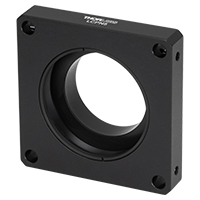
Click to Enlarge
Figure G12.1 SM2-Threaded Bore on an LCPN5 Adapter
- Internal SM2 (2.035"-40) Threading for SM2 Lens Tubes and Ø2" Optics
- Mount Optics Within a 60 mm Cage System Assembly
- Dovetail for Attachment to Cerna® and Select Nikon Microscopes
- Not Post Mountable
Our SM2-Threaded Cage Plates provide cage mounting of Ø2" optics along with SM2-threaded components, such as SM2 lens tubes. Both cage plates feature an internally SM2-threaded (2.035"-40) bore with a thread depth of 0.45" and include one SM2RR retaining ring to secure an optic. The LCPN4 and LCPN5 cage plates are 0.5" (12.7 mm) thick with a clear aperture of Ø1.74" (Ø44.3 mm) and Ø1.50" (Ø38.1 mm), respectively. Each cage plate has four Ø6 mm cage rod through holes with side-located locking setscrews (5/64" [2 mm] hex) to secure it within a 60 mm cage system.
Additionally, each cage plate features a dovetail to connect to certain Cerna microscope components as well as certain upright and inverted Nikon microscopes. The LCPN4 has a male D1N dovetail that connects to certain Cerna components, an inverted Nikon Eclipse Ti trinocular port, or an upright Nikon Eclipse trinocular port. The LCPN5 has a male D3N dovetail that connects to the condenser holder on a Cerna, inverted Nikon Eclipse Ti, or upright Nikon Eclipse microscope. For complete compatibility information, see the microscope-specific presentations.
The dovetail designations are specific to Thorlabs products; see the Microscope Dovetails tab for details.

- Dovetail for Attachment to Olympus Microscope Trinoculars
- Through Holes for 60 mm Cage Mounting
- 4-40 Tapped Holes for 30 mm Cage Mounting
- Not Post Mountable
The LCPY3 Cage Plate features a female D5Y dovetail to attach to Olympus trinoculars that have a male D5Y dovetail. The cage plate is 0.50" (12.7 mm) thick and unthreaded with a clear aperture of Ø1.26" (Ø32.0 mm). Four Ø6 mm cage rod through holes with side-located locking setscrews (5/64" [2 mm] hex) allow the cage plate to be secured within a 60 mm cage system. The side opposite the dovetail contains four 4-40 taps on 30 mm centers for mounting 30 mm cage systems. This cage compatibility allows Olympus trinoculars to be integrated into DIY Cerna® microscope systems.
The female D5Y dovetail on this cage plate can also be used with the LCPY2 cage plate above, which has a male D5Y dovetail, to create a quick connection between two segments of a cage system.
The dovetail designations are specific to Thorlabs products; see the Microscope Dovetails tab for details.

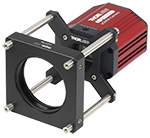
Click to Enlarge
Figure G14.1 LCP4S Adapter Mounted to
Quantalux® sCMOS Camera for
Compatibility with 60 mm Cage Components. Note the LCP4S adapter has
counterbored holes for 30 mm cage compatibility and through holes for 60 mm cage compatibility.
- Couples 30 mm and 60 mm Cage Systems
- Centered SM1 (1.035"-40) Tapped Hole
- Counterbore Holes for 30 mm Cage Mounting
- Through Holes for 60 mm Cage Mounting
- Not Post Mountable
The LCP4S Cage Plate Adapter provides a convenient means for coupling 30 mm and 60 mm cage assemblies via our Ø6 mm ER cage rods. The thin 4 mm (0.16") profile of this adapter is ideal for situations where axial space is limited. The centered SM1 (1.035"-40) tapped hole is compatible with our SM1-threaded lens tubes. Each of the outer through holes for 60 mm cage rods is accompanied by a side-located locking 4-40 setscrew, which can be secured using a 0.05" (1.3 mm) hex key. The inner holes for 30 mm cage compatability are counterbored for use with 4-40 x 3/16'' cap screws which are sold seperately (SH4S019 recomended). Unlike the LCP33(/M) cage plate adapter sold below, this cage plate adapter does not have a tapped hole for post mounting due to the thin profile.
Additionally, this cage plate adapter facilitates the mounting of our compact scientific cameras on 60 mm cage components (see Figure G14.1). For example, our 2CM2 Two-Camera Mount for Microscopes incorporates two LCP4S adapters. The thin profile of the adapter is required to position the image plane of the cameras within the adjustable focus range of the mount.


Click to Enlarge
Figure G15.1 LCP6X Adapter Mounted to a
Zelux® CMOS Compact Camera for
Compatibility with 60 mm Cage Components
- Couples 30 mm and 60 mm Cage Systems
- Centered SM1 (1.035"-40) Tapped Hole Accepts Ø1" Optics up to 0.08" (2 mm) Thick
- Through Holes for 30 mm and 60 mm Cage Mounting
- Not Post Mountable
The LCP6X Cage Plate Adapter provides a convenient means for coupling 30 mm and 60 mm cage assemblies via our Ø6 mm ER cage rods. The centered SM1-threaded (1.035"-40) hole is compatible with SM1-threaded lens tubes or Ø1" optics up to 0.08" (2 mm) thick (SM1RR retaining rings sold separately). Each cage rod through hole is accompanied by a side-located locking M4 x 0.7 setscrew that can be adjusted using a 5/64" (2 mm) hex key. These setscrews provide improved stability for attaching cage rods compared to the 4-40 setscrews used in the LCP4S cage plate adapter (sold above). Unlike the LCP33(/M) cage plate adapter, this cage plate adapter does not have a tapped hole for post mounting due to the thin profile.
Similar to the LCP4S adapter, the LCP6X adapter can facilitate the mounting of our compact scientific cameras on 60 mm cage components, as seen in Figure G15.1.

- Couples 30 mm and 60 mm Cage Systems
- Centered SM1 (1.035"-40) Tapped Hole Directly Accepts Ø1" Optics up to 0.35" (9 mm) Thick
- 8-32 (M4) Tapped Hole for Mounting to Ø1/2" Posts
The LCP33(/M) Cage Plate provides a convenient means for coupling 30 mm and 60 mm cage assemblies via our Ø6 mm ER cage rods. The centered SM1 (1.035"-40) tapped hole directly accepts optics up to 0.35" (9 mm) thick (SM1RR retaining rings sold separately). Each cage rod through hole in this cage adapter is accompanied by one side-located M4 x 0.7 locking setscrew which can be secured with a 5/64" (2.0 mm) hex key. The LCP33(/M) cage adapter also has an 8-32 (M4) tapped hole for Ø1/2" post mounting. The surface with the 8-32 (M4) tap is not wide enough to support Ø1" posts.
Additionally, two of these cage plates can be used to contain a 30 mm cage subassembly that can slide along the 60 mm cage rods as a single optomechanical unit. A 16 mm cage assembly can also be easily integrated using an SP15(/M) cage plate adapter.

- Ideal for Custom Machining to Mount Non-Standard Components
- Contains Four Corner-Located Through Holes
- Post Mountable with an 8-32 (M4) Tapped Hole
- Black-Anodized Aluminum
Blank cage plates are ideal when standard threads and hole sizes are insufficient for custom mounting and OEM-level requirements. Custom hole sizes and threads can be machined using any size drill bits and taps. These LC Series blank cage plates for 60 mm cage systems are ideal for use in optical systems that are based upon Ø2" optical components. Each cage plate contains four through holes machined for a precision slip fit with ER cage rods, which can be locked in place using 5/64" (2.0 mm) hex side-located locking setscrews. The LCP31/M has a small dimple to indicate that it is a metric part.

- Quick Drop-In Visual Beam Alignment Tool
- Small Through-Hole Aligned at Center of 60 mm Cage Assembly
The LCPA1 alignment plate provides a convenient tool for aligning 60 mm cage-based optical systems. This drop-in plate locates a Ø1 mm through-hole at the exact center of a cage assembly, providing a convenient visual target to assist in beam alignment.
 Products Home
Products Home














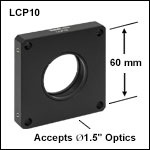
 Zoom
Zoom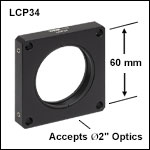
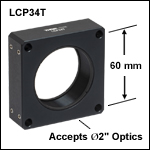

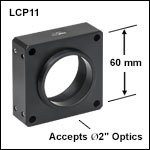

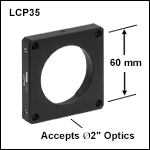
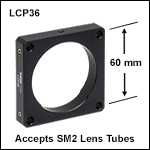
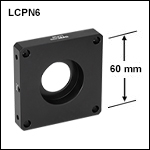
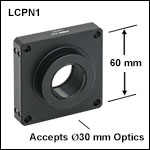
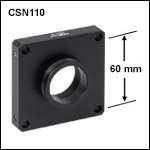

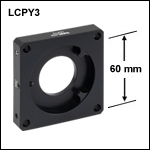
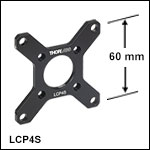
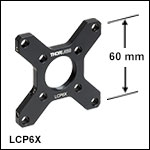
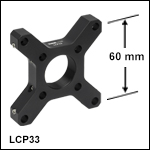

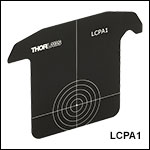
 60 mm Standard Cage Plates
60 mm Standard Cage Plates